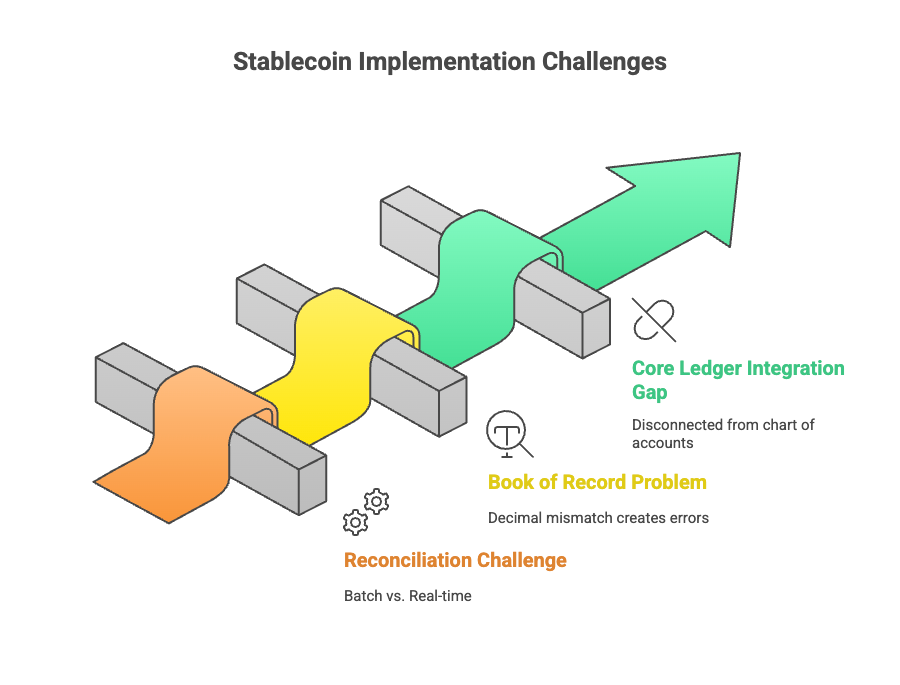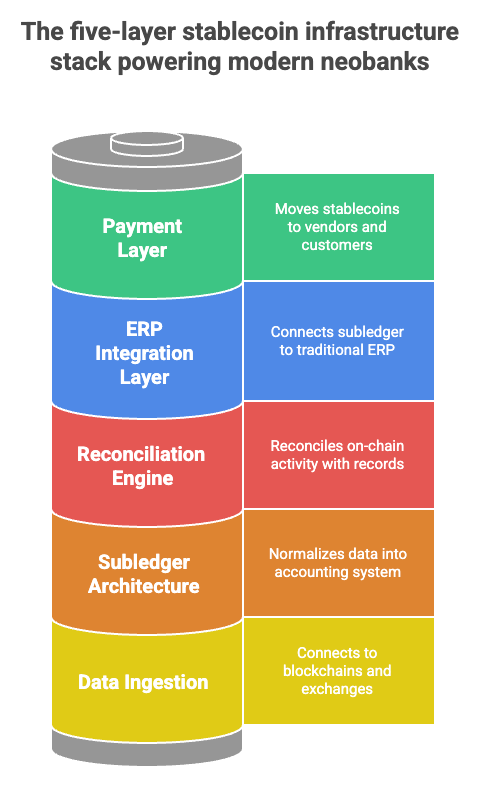
If you're running a neobank in 2026 and you don't have a stablecoin strategy, your board is probably asking why not. If you do have a stablecoin strategy, your finance team is probably asking why you thought this was a good idea.
The appeal is obvious. Your customers want to hold USDC. Your competitors are announcing crypto features. The regulatory fog is lifting—the GENIUS Act just removed payment stablecoins from securities regulation. And the economics are compelling: 80% lower fees than wire transfers, instant settlement, 24/7 operation.
So you build the customer-facing features. The wallet interface looks great. The onboarding flow is smooth. You integrate with a custody provider. You launch.
Then your controller tries to close the books and discovers that blockchain transactions settle in seconds but reconciliation still takes days. That your ERP doesn't handle 18-decimal-place precision. That cross-chain transfers create duplicate accounting entries. That "transaction hash 0x7f3b..." means nothing to your general ledger.
The technology for moving money works beautifully. The technology for accounting for that money movement? That's the hard part.

The Three-Headed Infrastructure Monster
Implementing stablecoins isn't just about choosing which blockchain to support or which custody provider to use. The real challenge is unglamorous back-office work that nobody talks about at conferences.

Data Ingestion Layer
The foundation is data ingestion. You need to connect to multiple blockchains—not just Ethereum, but Layer 2s like Polygon, Arbitrum, and Base, plus alternative L1s like Solana and Stellar.
Then there are exchange integrations. Major platforms need connections to Coinbase, Binance, Kraken, Gemini, and dozens of others. You need custodial wallet support for Fireblocks, BitGo, Anchorage, and NYDIG. For customers doing anything beyond basic transfers, you need DeFi protocol monitoring for platforms like Aave, Uniswap, Compound, and MakerDAO.
Transaction detection at scale is its own engineering challenge. You're not just pulling data—you're classifying it, detecting patterns, and identifying transaction types in real-time across heterogeneous systems.
The Reconciliation Challenge
Traditional finance operates in batch mode. Banks process transactions during business hours and reconcile overnight. Blockchain operates 24/7, with transactions confirming in seconds.
Each blockchain has its own transaction structure, timing, and cost model. The complexity multiplies across chains. Ethereum gas fees work differently than Solana.
Then there's the internal transfer problem. When you bridge assets between chains, you get a sent transaction on one chain and a receipt transaction on another. Your accounting system sees two transactions. It's one movement. Fail to collapse these, and you're double-counting everything.
Without automated mapping from on-chain data to accounting records, your finance team becomes human middleware. Manual reconciliation will never catch up.
The Book of Record Problem
Traditional ERPs handle two decimal places.
Blockchain transactions use 16, 18, or even 36 decimal places. This mismatch creates inaccurate accounting if you round. At scale, those errors compound into material misstatements.
You need a crypto-specific subledger that handles crypto natively and integrates with both blockchain and traditional ERPs. It needs to support various cost basis methodologies—GAAP and tax books simultaneously. It needs real-time balance tracking across wallets, exchanges, and custodians. And it needs audit trails that satisfy both traditional auditors and blockchain compliance requirements.
The Core Ledger Integration Gap
A blockchain transaction hash means nothing to your accounting software. Without ERP integration, crypto accounting becomes a parallel workflow, disconnected from your chart of accounts. Your controllers maintain two sets of books and manually bridge the gap at month-end.
You need to turn on-chain transactions into journal entries with correct GL mappings, cost centers, and entity codes. Multi-entity structures and FX calculations need to work automatically. Your existing approval workflows must be preserved too.
These three challenges compound. You can't solve reconciliation without a proper subledger. You can't maintain a subledger without ERP integration. And you can't integrate with your ERP without solving reconciliation. This is why most neobanks partner rather than build.
To understand what solving these challenges requires, let's walk through each infrastructure layer, using Bitwave's architecture as a reference. Bitwave processes billions in stablecoin transactions for enterprises including Coinbase.
What the Solution Looks Like

Data Ingestion Layer
The foundation is data ingestion. You need to connect to multiple blockchains—not just Ethereum, but Layer 2s like Polygon, Arbitrum, and Base, plus alternative L1s like Solana and Stellar.
Then there are exchange integrations. Major platforms need connections to Coinbase, Binance, Kraken, Gemini, and dozens of others. You need custodial wallet support for Fireblocks, BitGo, Anchorage, and NYDIG. For customers doing anything beyond basic transfers, you need DeFi protocol monitoring for platforms like Aave, Uniswap, Compound, and MakerDAO.
Transaction detection at scale is its own engineering challenge. You're not just pulling data—you're classifying it, detecting patterns, and identifying transaction types in real-time across heterogeneous systems.
The Subledger Architecture
Once you're ingesting data from 200+ sources, you need to normalize it into a coherent accounting system.
The subledger sits between blockchain chaos and your traditional ERP, acting as a translation layer. It handles transaction normalization across chains, turning wildly different data structures into standardized accounting events.
Automatic categorization is critical. Is this revenue? An expense? An asset transfer? An internal movement? The platform needs mechanisms to detect and collapse internal transfers so you don't double-count cross-chain swaps and wallet-to-wallet moves.
Cost basis tracking gets complex quickly. You need to support multiple methodologies—FIFO, LIFO, specific lot identification, weighted average. Different jurisdictions and tax strategies require different approaches.
And crucially, you need to handle those 18+ decimal places natively. No rounding. No precision loss. No material misstatements compounding over thousands of transactions.
Reconciliation Engine
With normalized data in your subledger, you need continuous reconciliation between on-chain activity and accounting records.
The real-time versus batch processing trade-off is crucial. Traditional accounting reconciles at month-end. For stablecoin operations, real-time reconciliation means your internal accounting records update instantly as transactions confirm on-chain. It's continuous, automatic synchronization across multiple blockchains, tokens, and vendor wallets.
You need to handle edge cases: failed transactions that consumed gas fees, stuck transactions, transaction replacements, and chain reorganizations. Multi-wallet and multi-entity reconciliation adds complexity when operating globally.
Segregation of duties matters for compliance. Different users need different roles and responsibilities within the platform, allowing them to reconcile transactions categorized in different ways. One user reconciles accounts receivable, another handles accounts payable.
ERP Integration Layer
The final layer connects your crypto subledger to your traditional ERP. This is where most build-it-yourself projects fail. It's not enough to generate journal entries—you need proper mappings, multi-entity structures, and existing control frameworks.
Direct API connections to leading platforms are essential. Integration with QuickBooks, NetSuite, Sage Intacct, and Xero needs to be native, not a CSV import hack. Journal entry generation needs proper GL codes, cost centers, entity codes, and all the metadata your controllers need.
Two-way sync is critical for data integrity. When you mark an invoice as paid in your ERP, that flows back to your crypto system. When a payment executes on-chain, that updates your payables in real-time.
The audit trail needs to provide granular detail required for stringent audit processes.
The Payment Layer
Infrastructure isn't complete without payment execution. This is where you actually move stablecoins to vendors, customers, and partners.
Vendor wallet verification is non-negotiable. You need built-in wallet verification to track and manage payments, with allow-list wallets and addresses for end-to-end security.
Batch payment capabilities are essential for operational efficiency. Your AP team shouldn't make individual transactions. They need to select multiple invoices, verify wallets against your allow-list, and execute bulk payments across tokens and blockchains in one operation.
Integration with custody providers is critical for security. Instead of managing private keys and hot wallets, enterprises can connect to existing custodial solutions like Coinbase Prime. This provides institutional-grade security while maintaining the speed and cost benefits of stablecoin payments.
Your Core Competency is Banking, Not Maintaining Crypto Infrastructure
The neobanks winning with stablecoins aren't the ones with the best blockchain engineers. They're the ones who made smart build-versus-partner decisions and got to market quickly with reliable, compliant systems.
Even companies like Coinbase, who arguably have more crypto engineering expertise than anyone, rely on Bitwave to move millions in vendor payments.
With Bitwave, you get battle-tested compliance and audit processes. With Bitwave you get audit-ready bookkeeping that businesses from Fortune 100 titans to early-stage crypto-native projects trust. Building equivalent compliance capabilities from scratch is expensive and risky. Your core competency is banking, not maintaining crypto infrastructure.
Ready to explore stablecoin infrastructure for your neobank? Contact Bitwave for a technical consultation.


Disclaimer: The information provided in this blog post is for general informational purposes only and should not be construed as tax, accounting, or financial advice. The content is not intended to address the specific needs of any individual or organization, and readers are encouraged to consult with a qualified tax, accounting, or financial professional before making any decisions based on the information provided. The author and the publisher of this blog post disclaim any liability, loss, or risk incurred as a consequence, directly or indirectly, of the use or application of any of the contents herein.






